Content
- 1 Advantages and disadvantages of late varieties
- 2 Popular cultivars of late ripening
- 3 Autumn varieties
- 4 Winter varieties
- 5 Video "Late Pears"
- 6 Why late varieties of pears are good
- 7 Belarusian late
- 8 Bere winter Michurina
- 9 Far East
- 10 Winter kubarevidny
- 11 Nika
- 12 May Day
- 13 Saratovka
- 14 Saint Germain
- 15 January
The southern beauty pear has been cultivated by man for 3 thousand years. Ancient Greeks and Romans knew about the culture, ancient records testified to the medicinal properties of the plant. Many centuries later, the pear is also loved by gardeners, and breeders have endowed the southerner with frost resistance, disease resistance and unfavorable environmental factors. Among hundreds of cultivars, late varieties of pears are most appreciated. Information about the advantages and disadvantages of the culture and varietal characteristics of several popular hybrids can be found in the materials of the article.
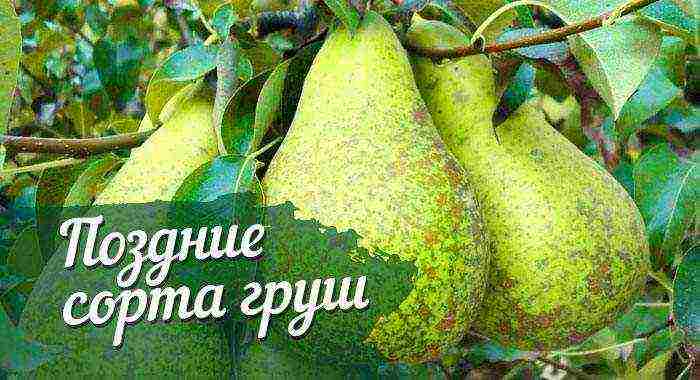
Advantages and disadvantages of late varieties
Beginners who decide to grow a late-ripening pear on the site should know that the fruits of such crops must be ripened. Harvested a little unripe, the fruits have a firm pulp and can hardly be called tasty. After reaching consumer maturity, the taste of pears becomes richer, a unique aroma appears, the pulp turns into melting ragweed. It was not for nothing that the ancient Romans called pears the food of the gods.
The consumer and removable ripeness of the fruits of late pears differs in terms.
Consider the main advantages of varieties ripening from late September to November:
- long storage period. After harvesting and ripening, the harvested crop is stored from a month to six months, being the best vitamin supplement throughout the winter;
- excellent taste characteristics are manifested during storage. Late pears are in no way inferior to eminent summer cultivars;
- in addition to attractive appearance, universal application is considered to be the advantage of the fruit. The fruits are good fresh, compotes, desserts, they are used to obtain dried fruits;
- high transportability makes it possible to cultivate crops on an industrial scale;
- most of the winter varieties are bred on the basis of the Ussuri pear. It is characterized by the highest degree of frost resistance, which is passed on to descendants.
Late pear has only one drawback - the ripening period. Unfortunately, those who want to taste the fragrant fruits as soon as possible will have to wait a long time.

To fully enjoy the grown harvest, gardeners prefer to grow several varieties with different ripening periods.
Subtleties of agricultural technology
Adult specimens with late ripening periods stand out among their congeners with a dark red or brown bark. Such trees are very demanding on the planting site, soil conditions. Avoid planting in winter-swept locations. Exposure to the cold wind leads to freezing of fruit buds, loss of yield. For fruit to ripen well, choose a place with good sun light. The close occurrence of groundwater leads to unpleasant consequences - in winter the pear is exposed to freezing, and in the spring it is destroyed due to flooding. To avoid root rot development, plant trees in a hole with drainage.
Remember that some varieties require pollinators. Choose seedlings strictly according to the recommended growing area.
Popular cultivars of late ripening
Consider the best pear varieties ripening from late September to November.
Saratovka
Medium-sized trees in Saratovka will bring their first harvest in 4-5 years.The greenish-yellow fruit is ready for harvest at the end of September, but will ripen a little later. As it ripens, the skin will turn golden and the flesh will be tender and juicy. The soft texture melts in the mouth, giving it a harmonious sweet and sour taste. Fruits weighing up to 150 g are stored for 4-5 months in a fruit storage. The advantages of the culture include winter hardiness, resistance to scab and fungal diseases. The variety is picky about moisture.
Red-sided
The parameters of the Red-sided tree are the same as those of Saratovka. Fruits with an oily skin are decorated with a bright crimson tan. Ripe fruits are yellow-green in color. Very tender and juicy pulp gives off light tart notes, estimated at 4.5 points. Harvesting maturity occurs by the end of September, but you should not hesitate with harvesting, because the fruits are prone to shedding. Fruits collected in the recommended time frame are stored for 30-90 days. Late pear varieties Krasnobokaya are resistant to diseases, withstand severe frosts.
May Day
Pervomayskaya forms trees of medium vigor with a compact crown that requires minimal maintenance. Saplings are winter-hardy, they are not afraid of diseases. Juicy, sour-sweet pulp is hidden under an oily skin with a thin waxy coating. Skin color at the time of harvest is green with little or no blush. When a large (up to 230 g) fruit ripens, the peel becomes yellow with a scarlet blush. Harvesting is carried out at the end of September, after ripening, a characteristic intense aroma appears. The juice-rich pulp has a pleasant sweet taste with a refreshing acidity and astringency inherent in the variety.
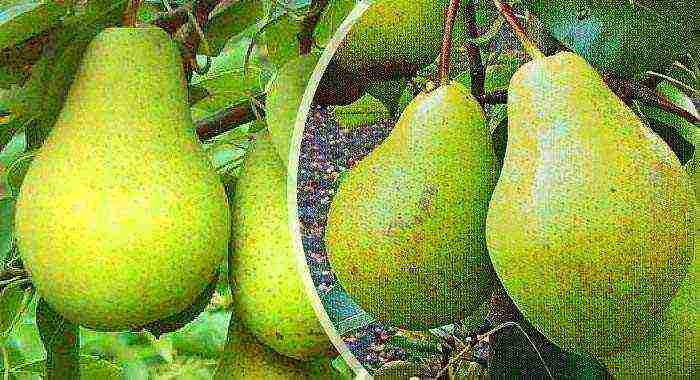
The advantages of Pervomayskaya include:
- long storage period - fruits do not deteriorate in storage conditions 7-8 months
winter hardiness of the culture is very high; - high productivity;
- fruiting that occurs 5-6 years after planting;
- good immunity of the tree to fungi.
Of the shortcomings, gardeners note a tart taste that is lost during heat treatment.
Veles
Hearing the name "Veles", many gardeners remember a high-yielding variety with high winter hardiness and strong immunity. Fruits weighing 150-220 g are ready to be picked in the first decade of September. The thick greenish-yellow skin is covered with a bright orange tan. The fruit has a great sweet taste that rivals southern cultivars. Each Veles tree can please with a harvest of up to 100 kg.
The pear has several disadvantages:
- low early maturity - 6-7 years;
- the need to ration the crop by removing excess ovaries;
- the tendency of fruit buds to freeze;
- susceptibility to wasps attack on juicy fruits.
Winter kubarevidny
Trees of medium vigor bring harvest in the first ten days of October, but the first fruits will take about seven years to wait. Juicy sweet pears with a slight sourness in the taste are covered with a rough skin. The color of the peel of a ripe fruit is golden with a rich crimson blush. Pears weigh up to 200 g and are stored until the end of winter. Consumer maturity comes in December. The variety is resistant to growing conditions, winter-hardy, consistently brings good yields. Scab is extremely rare.
Thumbelina
The Thumbelina hybrid appeared on the market in the late 90s. Saplings form slow-growing low trees with a rounded crown, consisting of drooping branches. The name of the cultivar was given for small fruits weighing up to 70 g. Thin yellow rind hides a very sweet fragrant pulp, rich in juice.
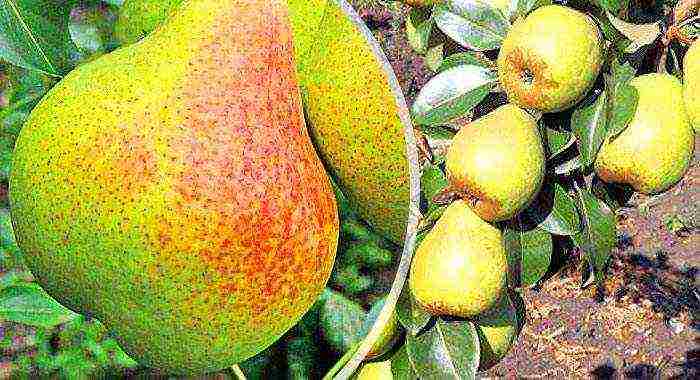
Sugar in the fruits of Thumbelina accumulates regardless of weather conditions.
It is better to harvest the crop by mid-September, otherwise the fruit will crumble and become unsuitable for storage. The fruit storage allows you to enjoy a gentle harvest for up to 100 days. Although the yield of the hybrid is average, gardeners leave excellent reviews about it. The frost resistance of the culture is high, and the taste and marketability will not leave you indifferent.
Late
Bred at the Timiryazev Moscow Academy, the Late Pear (TSKHA) has excellent qualities:
- medium height and compact crown;
- attractive fruits weighing up to 140 g with an interesting ovoid shape;
- thin, smooth skin of a greenish tint with a slight blush;
- tender sour-sweet yellowish pulp;
- shelf life up to 100 days.
The cultivar is resistant to cold, brings consistently good yields, is not susceptible to diseases.
Belarusian late
The first crop of Belorussian Late will appear on the branches in 3-4 years. A medium-sized tree has a dense, rounded crown. Wide pear-shaped yellow-orange fruits weigh up to 120 g. A raspberry tan appears on the surface of the dense peel as it ripens. Sweet white pulp is complemented by gentle sourness. The harvest harvested in September shows all shades of taste only at the beginning of winter, it is stored for up to 5 months. Among the shortcomings, the susceptibility to scab and the frequency of yield were noted.
Bere winter Michurina
The cultivar comes from the Ussuri pear, so there is no reason to doubt its frost resistance. The yield of the variety bred by IV Michurin is consistently high, but it will take 6-7 years to wait for the fruit to appear. Ripe fruits weighing 120 g of a golden hue with a red blush. The shape is slightly elongated, asymmetrical. Juicy dense pulp has a pronounced astringency in taste. The hybrid is resistant to scab, the keeping quality of the crop is up to 5 months.
The description of late varieties will help you choose a seedling based on your own preferences. Such a tree will bring a good harvest that will surprise even discerning gourmets.
All varietal pears are traditionally divided into three types according to the ripening time: summer, winter and autumn pear varieties. Autumn and winter are also called late. The article will tell in more detail about these varieties: it contains descriptions of the most interesting in our opinion, which will grow and develop well in summer cottages.
Summer pears reach maturity in August and do not differ in storage duration, limited to 10-15 days. But the late ones, in addition to ripening in the fall, can be stored for up to three months (and some even longer). At the same time, it is recommended to collect fruits from trees unripe - in this case, their shelf life increases and they acquire an unforgettable original taste.
Autumn varieties
Late autumn pear varieties traditionally ripen in late September or early October. The removable period does not exceed 10 days, after which the fruit falls off. If the summer was sultry, without rain, then the interval between ripening and removal is reduced, and if it was cool, the period increases. After removal, they are stored for up to one month. Consider the most interesting types for private gardens and summer cottages.
Veles
These pears ripen in early autumn, at the beginning of September. The beginning of fruiting is 5-7 years. Large fruits (weight up to 200 g), greenish-yellow with creamy pulp, have a pleasant taste. The harvest can be up to 100 kg.
Ripe fruits can be eaten straight from the tree - they already taste good, but can also be stored until December at a temperature of +2 degrees Celsius.
It is advisable not to wait for full ripening - at the beginning of September. If the weather is hot, fruits are very popular with wasps, as a result of which they often crumble and become unsuitable for transportation and long-term storage.
Advantages:
- regularity of fruiting;
- high frost resistance;
- resistance to most diseases;
- great taste.
Flaws:
- a decrease in the size of fruits was noted with a good harvest (thinning of the ovaries is necessary).
Thumbelina
This autumn variety reaches maturity in September. The first harvest is for 6-7 years. Medium-yielding tree - up to 90 kg. Fruits are medium (up to 80 g), yellowish-brown, with creamy pulp, juicy and sweet. Pears can retain their taste until January - December.
Advantages:
- regularity of fruiting;
- good winter hardiness;
- wonderful fruit taste.
Flaws:
- late onset of fruiting;
- small fruit size.
Elegant Efimova
September grade.The first harvest is 4-6 years from the moment of planting. Productivity - up to 100 kg of fruit weighing up to 120 g. Color - greenish-yellow. The pulp is creamy.
Feature - fruits must be removed while still green, not allowing ripening on the tree. In this case, after 2-3 days of ripening at a temperature of 2-3 degrees Celsius, the fruits acquire an original pleasant taste and are stored for 2-3 weeks.
Advantages:
- early maturity;
- winter hardiness;
- scab resistance;
- constant high yield.
Flaws:
- special maturation control is required.
Winter varieties
Gardeners often ignore winter varieties of pears, mistakenly believing that they do not taste good enough. However, one detail should be noted. Fruits ripen mainly at the end of September, but it is recommended to harvest them as late as possible, while avoiding overripe. If properly removed from the tree, they are stored at low temperatures for up to 5 months, gradually reaching consumer maturity. And this is their main difference from other types of pears.
May Day
The first harvest is 5-6 years, while the yield is high. It matures in the third decade of September, rather large (up to 220 g), predominantly green in color, which changes during storage to greenish-yellow. The pulp is creamy, aromatic and tart taste. Once removed, the fruit can be stored for up to 250 days (subject to low temperatures).
Advantages:
- long shelf life;
- high winter hardiness;
- resistance to many fungal infections.
Flaws:
- slight astringency of fruits.
Rossoshan late
This winter pear ripens by the end of September. The first harvest is 5-6 years. Productivity - up to 50 kg, however, the yields are uneven from year to year. Fruits are large, up to 350 g, greenish in color. Reaching full maturity, they change color to yellow and are stored for 3-4 months. The pulp is creamy, has a pleasant, juicy taste.
Advantages:
fruit quality;
resistant to frost.
Flaws:
- does not tolerate waterlogging;
- may be affected by fungal infections;
- periodic yield.
Belarusian late
Winter pear varieties are complemented by this early-growing tree - the first harvest is already 3-4 years old. Ripening occurs towards the end of September. Yields are high, but periodic. Fruits are medium in weight (up to 120 g), green in color, but reaching consumer maturity, they change color to orange-yellow. The pulp is white, has a sweet and sour taste. Shelf life is until February, and in some cases, fruits are perfectly preserved until March.
Advantages:
- early maturity;
- storage duration;
- high winter hardiness.
Flaws:
- frequency of yield;
- prone to scab infection.
Lyre
A pear bears fruit for 4-5 years, reaching a yield of up to 70 kg per tree. Ripening occurs by the end of September. Fruits up to 200 g, green, with sweet white pulp. The harvested crop can be stored until December.
Advantages:
- early maturity;
- the regularity of the harvest.
Flaws:
- weak winter hardiness.
Video "Late Pears"
This video will tell you about the late pear varieties.
In order for winter and autumn varieties of pears to grow successfully and give consistently high yields, it is necessary to first study the information about the pros and cons of the tree, be sure to take into account the composition, acidity of the soil and the depth of groundwater at the site of the future planting of the seedling. Only after studying all the nuances and choosing a seedling suitable for all conditions, as well as constantly carrying out the correct agrotechnical measures, can we expect regular abundant fruiting.
Among the huge variety of pears, winter varieties stand out for their long shelf life, frost resistance and suitability for conservation. We have selected winter varieties recognized by experts as the best in terms of yield.
The pear is more sensitive to frost than the apple tree, so breeders for a long time could not get truly winter-hardy varieties. But now this problem has been resolved.Even residents of the northern regions can find excellent pear varieties for themselves, which will be stored for several weeks, and sometimes months!
Why late varieties of pears are good
Among inexperienced gardeners, there is an opinion that winter pears are tasteless and hard. However, many people forget that the dates of removable and consumer maturity in winter pear varieties do not coincide. The removed fruits must lie down for some time before acquiring their characteristic taste characteristics.
The fruits of winter pears are distinguished by tender and sweet pulp, they contain a large amount of vitamins and useful biologically active substances.
The indisputable advantages of winter pear varieties are:
- long shelf life (5-6 months);
- resistance of the tree to severe frosts;
- rich taste and aroma that pears acquire in the ripening process;
- attractive fruit appearance;
- they can be preserved.
According to the shelf life, pears are divided into three groups:
- early winter (Kure, Nart, Noyabrskaya, Elena, Zolotovorotskaya, etc.) - stored in the refrigerator until mid-January - early February;
- winter (Saratovka, Kondratyevka, Pass-Crassan, Olivier de Serre, Kirghiz winter, etc.) - stored in the refrigerator until the end of March;
- late winter (Tikhonovka, Emerald, Zest of Crimea, Maria, Winter Dekanka, etc.) - stored until early May.
We have selected varieties suitable for most climatic zones, thanks to their winter hardiness and excellent taste.
Belarusian late
A variety that won't let you down. Fruits of the correct wide-pear-shaped shape. In the period of removable maturity (mid-September), these pears are green with light brown spots, subsequently a red-brown blush appears on them. During storage, the color of the fruit changes to yellow with orange spots and a raspberry blush. The pulp of Belorusskaya late is juicy, white, fine-grained, has a pleasant, sweet, slightly sour taste. Advantages of the variety: winter hardiness, high yield, excellent keeping quality.
| Entering fruiting | Tree height (m) | Fruit weight (g) | Harvest | Shelf life (days) | |
|
3-4 years |
Up to 4 |
110-120 |
Mid - end of September |
150-180 | |
Bere winter Michurina
In terms of yield, the trees of this variety, bred by IV Michurin himself, are superior to many other varieties. Fruits are medium-sized, classic pear-shaped, with slight asymmetry. The main color of pears is light green, subsequently a reddish blush appears on the skin. During storage, pears turn yellow, the blush becomes larger. The pulp of the fruit is white, juicy and firm, with a slight tart aftertaste. The variety is resistant to scab, but its winter hardiness is average.
| Entering fruiting | Tree height (m) | Fruit weight (g) | Harvest | Shelf life (days) | |
|
For 6-7 years |
4-5 |
120-140 |
End of September |
130-150 | |
Far East
An early winter fruitful variety of pears. Fruits are small, regular pear-shaped, yellow, with numerous brown blotches. Their flesh is white, juicy, with dense, hard lumps. Pears are delicious, sweet and sour, with a pleasant aroma and aftertaste (just let them sit). The advantages of the variety include high winter hardiness and absolute resistance to scab.
| Entering fruiting | Tree height (m) | Fruit weight (g) | Harvest | Shelf life (days) | |
|
For 4-5 years |
2-3 |
80-100 |
Third decade of September |
50-70 | |
Winter kubarevidny
The memorable name is associated with the fruits of a cuboid shape (rounded cube). Their skin is dense and rough, green in color, sometimes with a dull raspberry blush. During storage, small gray subcutaneous dots appear on it. The pulp is white, very juicy, with a rich sweet and sour taste. The variety is distinguished by good frost resistance and insensitivity to scab. In addition, the Winter Kubarevidnaya annually pleases with a bountiful harvest, which is stored for up to 6 months.
| Entering fruiting | Tree height (m) | Fruit weight (g) | Harvest | Shelf life (days) | |
|
For 6-7 years |
3-4 |
180-200 |
Early October |
150-180 | |
Nika
"Goddess of Victory" among pears. The tree is medium-sized, the fruits are truncated-conical, rounded. The skin is smooth and oily, with a waxy coating. The main color of the fruit is greenish with red spots. In the period of consumer maturity, pears become light yellow, brownish-red spots cover the entire surface of the fruit. The pulp is creamy, medium density, fine-grained, buttery consistency. The taste is sweet with sourness. The variety is highly winter-hardy, prone to scab and entomosporiosis.
| Entering fruiting | Tree height (m) | Fruit weight (g) | Harvest | Shelf life (days) | |
|
For 5-6 years |
3-4 |
150-200 |
Second decade of September |
90-100 | |
May Day
Winter variety with a festive name. Fruits of regular shape with oily skin and waxy bloom. The main color of pears is green, with a pink blush on the side facing the sun. During the storage period, the fruits do not get sick (as it might seem), they just change color to greenish-yellow with a brown blush. The pulp is creamy, medium density, semi-oily, juicy, very aromatic. The taste is sweet and sour, with an implicit astringency. The variety is winter-hardy and absolutely resistant to fungal diseases.
| Entering fruiting | Tree height (m) | Fruit weight (g) | Harvest | Shelf life (days) | |
|
For 5-6 years |
3-4 |
150-220 |
Second decade of September |
220-250 | |
Saratovka
Variety - "middle", which belongs to the late autumn-early winter. The fruits are elongated pear-shaped, with a smooth, oily skin and small dots on it. The main color of pears is greenish-yellow; as they ripen, they acquire a bright golden-yellow color. The pulp is white, tender and soft with a pronounced sweet and sour taste, without astringency, very juicy. The pear tolerates winter well, but drought is worse. The variety is immune to pear scab and powdery mildew.
| Entering fruiting | Tree height (m) | Fruit weight (g) | Harvest | Shelf life (days) | |
|
For 4-5 years |
4-5 |
120-140 |
End of September |
120-150 | |
Saint Germain
The variety has been known since the 19th century under the name Good Louise. Despite its Western European origin, it is grown in Central Asia and other southern regions and temperate zones. The fruits are large, oblong-ovoid. The skin is thin, dense and firm, but sensitive to shock and damage, so fallen pears quickly rot. As it ripens, the pear changes color from light green to yellow. Rust points are scattered on the surface of the fruit in large numbers, sometimes they can form a continuous mesh or large spots (this is normal). The pulp is greenish-white, of medium density, with a fragrant aroma and refreshing taste, juicy and sweet.
| Entering fruiting | Tree height (m) | Fruit weight (g) | Harvest | Shelf life (days) | |
|
For 4-6 years |
Up to 6-7 |
180-220 |
End of September |
120-150 | |
January
Fresh treats for the New Year's table. Fruits are medium in size, broadly pear-shaped. The skin is smooth, rough, matte. The main color of the pear is greenish; during the period of consumer maturity, the fruits acquire a yellowish tint. On the sunlit side of the pear, over time, a brown tan appears, turning into a reddish blush. The subcutaneous dots are green, clearly visible. The pulp is white with a greenish tint, juicy and sweet. The variety is quite resistant to scab and severe frosts.
| Entering fruiting | Tree height (m) | Fruit weight (g) | Harvest | Shelf life (days) | |
|
3-4 years |
3-4 |
130-150 |
Mid - end of September |
120-150 | |
Winter varieties of pears are highly productive. And their fruits can be stored almost until the new harvest, becoming more tasty and aromatic over time. Set aside some space in your garden for them and you can enjoy your own delicious pears all year round.
.
Both a beginner and an experienced gardener would like to plant a variety of fruit trees in their area. The beauty of the garden is important, but for many, the harvest comes first. Should you plant late varieties of pears? Which one should you choose? We will answer these and other questions.We will tell you what late pears are, with a photo, we will make a description of them.
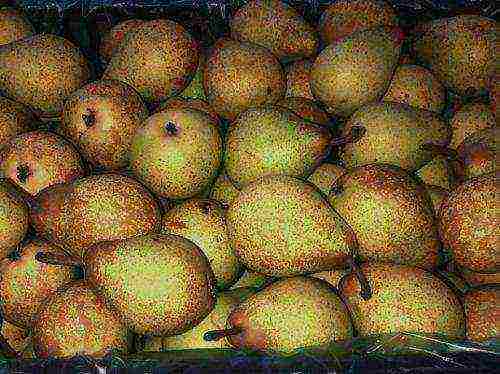
Late pears, if stored properly, can be used until spring.
About late varieties
Many novice gardeners do not want to plant winter varieties of pears on their site, because they believe that the harvest will be firm? tasteless. This is a common misconception. But the fruits of these varieties will later become even better than those of the popular summer pear varieties.
They need time to lie down and mature. They contain many vitamins and nutrients, they have a sweeter and more tender pulp.
Pros:
- They can be stored for a long time. If all conditions are created, they will lie in one place for up to 5-6 months.
- The trees can withstand severe frosts. Pears are not as strong as apple trees, they are afraid of severe cold. But now varieties have been bred that do not die even at low temperatures.
- Taste. Even if you remove the hard fruits, over time they will acquire a unique aroma and taste.
- Transportability. These varieties are also grown on an industrial scale, since they are easy to transport from place to place, they do not deteriorate.
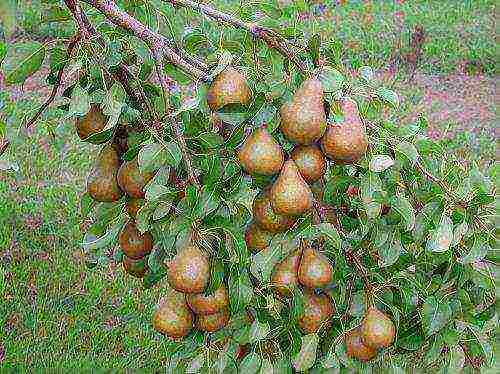
Late pears are removed from the tree at the end of September
They have one minus: the harvest is harvested in late autumn, and you will have to wait until it ripens, that is, in the summer and early autumn, it will not work to eat pears. Therefore, gardeners plant different varieties on their site, both summer and autumn.
Late varieties include autumn varieties that ripen from September to November. It is necessary to have time to collect them in 10 days, otherwise they will crumble.
If the summer is hot, without rains, you need to hurry up, because this period is reduced, and with a cool summer, it increases. These are also winter varieties of pears that ripen from the end of September. But they are advised to collect them later. If you harvest on time, then they do not deteriorate until 5 months. Consider pear late varieties description photo. Autumn varieties are stored longer than summer varieties, but the record holders in storage are winter ones. These fruits can be eaten fresh, made from them jam, jelly, compotes.
Autumn varieties "Veles"
This is a famous variety, the description of which also attracts experienced gardeners. At a young age, the tree has a spreading crown, which then changes shape, becomes wide-pyramidal. She has a stable high yield. This variety is hardy and resistant to many diseases. The pear itself is green or slightly yellowish, with a pleasant orange blush on its surface. The fruits are large, with a smooth surface. They have delicious creamy flesh, juicy and tender. Up to 100 kg of pears are removed from one tree. The fruits do not need to be stored, but are eaten immediately after harvesting, they are already tasty and juicy. Stored until December, ripen in early September.
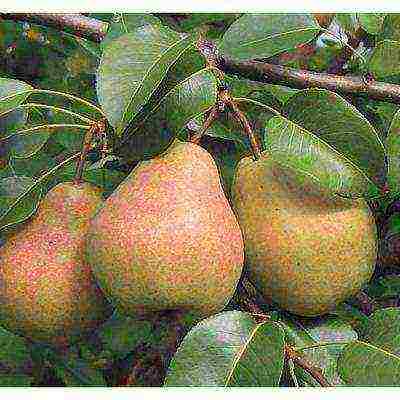
Veles pear has a very pleasant taste
On hot days, they suffer greatly from wasps, so it is better to remove them in advance before they ruin the harvest.
Red-sided
This is a late autumn variety. It has medium-sized trees, which grow fruits weighing from 130 to 150 g. They are covered with oily skin. The color of the fruit is green, but over time they turn yellow. They are decorated with a beautiful crimson blush. They have a juicy pulp, which is particularly tender and astringent. The taste scored 4.5 points, the fruits are grown for human consumption. They ripen at the end of September, after which they crumble. Stored for 1 to 3 months.
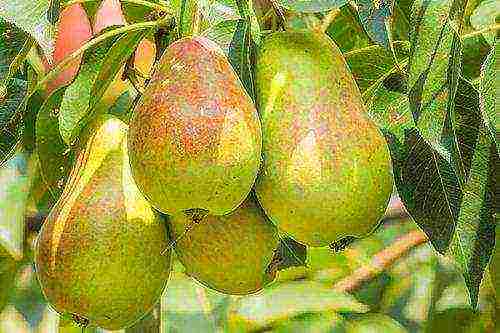
Pear Red-sided - fruits
When making a description of the variety, it is worth highlighting that it is winter-hardy, withstands severe frosts, and is resistant to many diseases.
Thumbelina
It is a small tree with a dense, rounded crown. It has small fruits, which weigh from 60 to 70 g. Pears are smooth, covered with a thin skin, yellow in color. They have juicy flesh melting in the mouth, sweet and aromatic. Pears become sweet regardless of weather conditions, that is, during rainy summers. The fruits ripen in mid-September, by this time it is better to collect them, otherwise they will begin to crumble. In the refrigerator, the crop is stored for up to 100 days.
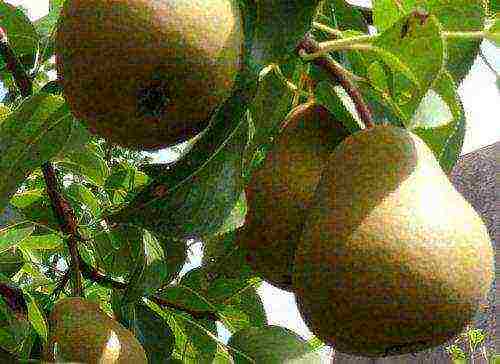
Pear Thumbelina is medium-sized, but very tasty
The tree bears a stable harvest, but there are not many fruits, the yield is average. It tolerates severe frosts in winter and does not freeze during spring frosts.
Bere Bosc
They have vigorous trees that grow to large sizes. The fruits are large, weighing about 180 g, but sometimes they grow up to 250 g. They have white or slightly creamy flesh, melting in the mouth, sweet, juicy. It tastes like almonds and spices. Experts highly appreciated this variety, giving it 4.4 ̶ 4.8 points out of 5 possible.
But with long-term storage, their taste is lost, the pulp becomes dry and hard.
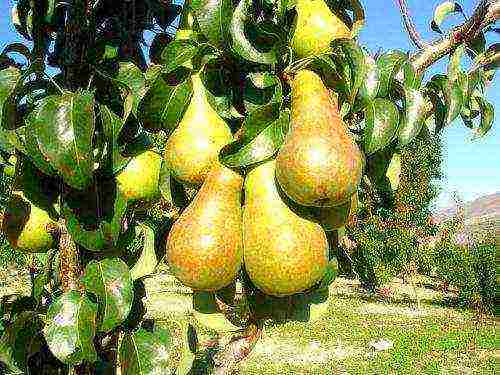
The Bere Bosk variety is stored only until the New clan
Pears ripen in the first half of September and stick tightly to the branches, and do not crumble because of the strong wind. The fruits are not eaten immediately, but 20 days after ripening. But they are not stored for a long time, about 30 days. Making a description of the variety, I would like to say that the trees have low winter hardiness, they freeze out in the conditions of the Crimea, if the winters were harsh. Their drought tolerance is also low, and disease resistance is good.
These are not all autumn varieties of pears, there are too many of them. We have listed a few of the most famous ones.
Winter varieties Pervomayskaya
It is a medium-sized tree with a compact crown. Fruits are either medium in size, or slightly above average, smooth, covered with an oily skin with a waxy coating. During harvest, pears are green, sometimes with a slightly pink tint, and during the ripening period they turn yellow with a red blush. They have a juicy pulp, slightly tart, sour-sweet in taste, with a pleasant strong aroma. The fruits are harvested in September, in the second half of the month. If stored properly, they do not deteriorate for 220-250 days.
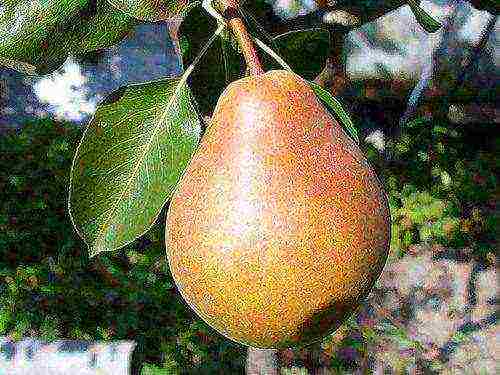
Pervomayskaya variety ripens in October
These trees are winter-hardy, not afraid of fungal diseases.
Belarusian late
This variety has medium-sized trees with a dense crown. It has medium-sized fruits, which weigh from 100 to 120 g, covered with dry skin of medium thickness. They are plucked green, there may be a reddish blush on top, but gradually they turn yellow, acquire an orange tint, the blush is crimson. The pulp of the pear is oily and juicy, with a slight refreshing sourness. The fruits are harvested in September, and they lie for up to 5 months, without spoiling and without losing their taste.
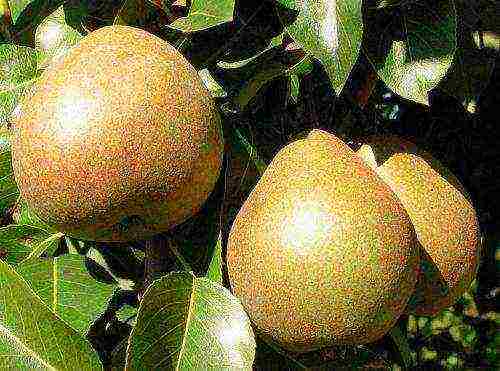
Belarusian late pear - fruits
They can be eaten in January or February, but their taste remains until March or April.
Winter kubarevidny
The tree size of this pear is medium. The fruits weigh from 150 to 200 g and are covered with a rough but smooth skin. At the time of harvest, they are green, and there is also a pink blush. When pears ripen, they turn yellow, golden, blush - crimson. They have a fragrant juicy pulp, with a sweet taste and a sour aftertaste.
Harvested in early October, but eaten in December.
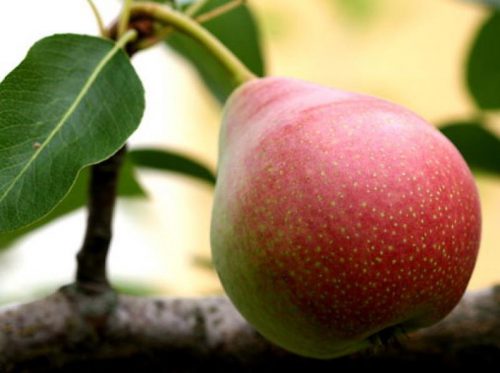
The Kubarevidnaya variety has very beautiful fruits
The fruits do not spoil until March, the yield is high, the pear bears fruit every year. Making a description of the variety, we will focus on its winter hardiness and drought resistance. It is not affected by scab or does not suffer from it much. But the first fruits will appear only after 6 or 7 years.
Nika
The trees are medium in size. Fruits are medium in size or larger, weighing from 130 to 150 g, some specimens reach 200 g. They are covered with oily skin. The fruits are removed green, they may have a red blush, later they turn yellow, with a red blush. They have creamy flesh, tender, with a slight aroma of nutmeg, its taste is 4.4 ̶ 4.5 points. Pears ripen at the end of the first month of autumn and are stored for 3 or 4 months. This variety is winter hardy, resistant to many diseases.

Pear Nika bears fruit well even in the northern regions.
Kuban late
It is a medium-sized tree with a medium-dense crown. He has fruits weighing 150 g, with a rough dry skin. They are harvested green, there is a slight tan on the sunny side, later they turn yellowish.The pulp of pears is yellowish, oily and tender, aromatic, with a sweet-sour taste. In the Kuban, it is harvested at the end of September, it is stored until mid-January, without losing its taste.

Kuban late - a very productive variety
Grows on any soil, undemanding, scab resistant, not afraid of frost and drought.
Subscribe Be aware of new products on our site

